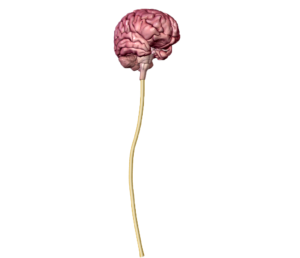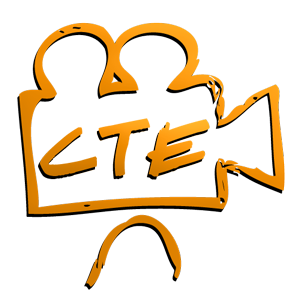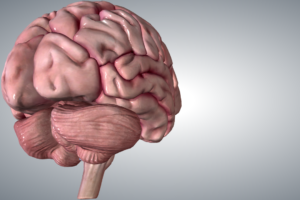The Nervous System
Categories: New Videos Added to CTE Skills Library
The Nervous System
The “GREAT” and mighty Nervous System…or The BRAIN as most of us call it. What makes this organ unique is that within it lies the ability for Humans to know oneself. This feature distinguishes and sets the Human species apart from the rest of creation. This ability is known as “Consciousness or “Intelligence”.
Primary Function
To begin, let’s look at the primary function of The Nervous System. The basic purpose is to coordinate all of the activities of the body. It enables the Body to respond and adapt to changes that occur both inside and outside the body.
Now the Nervous System is actually split into two parts. The central nervous system, and the peripheral nervous system. We’ll explore the peripheral later but first let’s look at the central nervous system.
The Central Nervous System
The Central Nervous System is made up of two major structures.
- The Brain
- The Spinal Cord
The Brain
As most people know, the brain is found within the cranium or skull; and there are six main sections among other structures within it.
These six sections are the Cerebrum, Cerebellum, Diencephalon, the Mid-brain, Pons, and the Medulla Oblongata.
Cerebrum
The first section is the cerebrum. This is the largest section. It is divided into two major hemispheres which are the right and left hemisphere; and the cerebrum is further divided into four Lobes. These four lobes are the frontal, the parietal, the temporal, and the occipital.

- Frontal – The frontal lobe is primarily responsible for reasoning, and thought.
- Parietal – The Parietal is primarily responsible for integrating sensory information.
- Temporal – The Temporal is primarily responsible for processing auditory information from the ears.
- Occipital – …and the Occipital is primarily responsible for processing visual information from the eyes.
Cerebellum
The second section of the brain is the Cerebellum. This is the section located in the back of the head below the cerebrum and above the 1st cervical of the neck… It is responsible for muscle coordination, balance, posture and muscle tone.
Diencephalon
This section is found between the Cerebrum and midbrain. It contains two structures: The thalamus, and the hypothalamus
- the thalamus – behaves much like a relay station and directs sensory impulses to the Cerebrum
- the hypothalamus – controls and regulates autonomic functions, such as temperature, appetite, water balance, sleep, and blood vessel constriction and dilation. The Hypothalamus also plays a role in the emotions, such as, anger, fear, pleasure, pain, and affection.
Midbrain
The midbrain section is located below the Cerebrum at the top of the brainstem. It is responsible for certain eye and auditory reflexes.
Pons
The Pons is located below the midbrain and in the brainstem. Is responsible for certain reflex actions such as chewing, tasting, and saliva production.
Medulla Oblongata
And the last section is the Medulla Oblongata. It’s the lowest part of the brain stem. It connects with the spinal cord and is responsible for regulating heart and blood vessel function, digestion, respiration, swallowing, coughing, sneezing and blood pressure. It is known as the center for respiration.

The Spinal Cord
Now that we’ve covered the brain, let’s take a look at the other half. The Spinal Cord.
The spinal cord is the link between the brain and the nerves in the rest of your body. The spinal cord is divided into four different regions: the cervical, thoracic, lumbar, and afferent and efferent spinal nerves, which merge to form peripheral nerves.
- the afferent spinal nerves are responsible for carrying information from the body to the brain.
- The efferent spinal nerves are responsible for carrying information from the brain to the body.
 Peripheral Nervous System
Peripheral Nervous System
Within this elaborate system of nerves , neurons, and dendrites there is a system that regulates the functions of the CNS which lie outside its major components such as the brain and the spinal cord.
This system is Known as the Peripheral and is subdivided into two smaller systems.
- The Somatic System
- Autonomic System
The Somatic Nervous System
The Somatic System is responsible for carrying motor and sensory information both to and from the CNS. This system is made up of nerves that connect to the skin, sensory organs, and all skeletal muscles.
The somatic system is also responsible for nearly all voluntary muscle movements, as well as for processing sensory information that arrives via external stimuli including hearing, touch and sight.
The structures that allow this communication to happen between the nerves throughout the body and the CNS are known as the Afferent sensory neurons and the Efferent Motor Neurons.
Now afferent simply means “conducting inward” and efferent means “conducting outward”. So just like the spinal nerves, the Afferent neurons take information from the nerves to the CNS
and the efferent neurons take information from the CNS, to the muscle fibers throughout the body.
The Autonomic Nervous System
The Autonomic System is further divided into the sympathetic system and the parasympathetic system.
- The Sympathetic Nervous system is vital to our survival. Have you ever heard of the “Fight or Flight” response to danger? The sympathetic nervous system revs up the body when confronted with imminent danger to either defend yourself or to escape the threat.
- The Parasympathetic Nervous system is the counterbalance to the sympathetic response to danger, whether real or imagined. Once the threat is gone the parasympathetic brings all systems o f the body back to normal.
Recap
At this point you should have a basic understanding of the Nervous System. But lets do a quick recap.
- The basic purpose is to coordinate all of the activities of the body. It enables the Body to respond and adapt to changes that occur both inside and outside the body.
- The two major parts are the Central Nervous System and the Peripheral Nervous System.
- The Central Nervous System is also divided into two major structures. The Brain and the Spinal Cord.The Brain is found within the skull, or cranium and it is made up of 6 main sections. –
- These six are the Cerebrum, Cerebellum, Diencephalon, the Midbrain, Pons, and the Medulla Oblongata.
- The other half of the Central Nervous System is the Spinal Cord. The spinal cord is the link between the brain and the nerves in the rest of your body. The spinal cord is divided into four different regions: the cervical, thoracic, lumbar and, afferent and efferent spinal nerves, which merge to form peripheral nerves.
- Now that we know the Brain and Spinal Cord primarily make up the Central Nervous System, let’s look at the Peripheral Nervous System.
- The Peripheral Nervous System is essentially, the Nervous System outside of the brain and spinal cord. The Peripheral Nervous System is subdivided into two smaller systems called the Somatic Nervous System, and the Autonomic Nervous System.
Closing
So, as you can see, the Nervous System is quite complex, and this is just the tip of the iceberg so to speak.
Look for more videos at CTEskills.com


